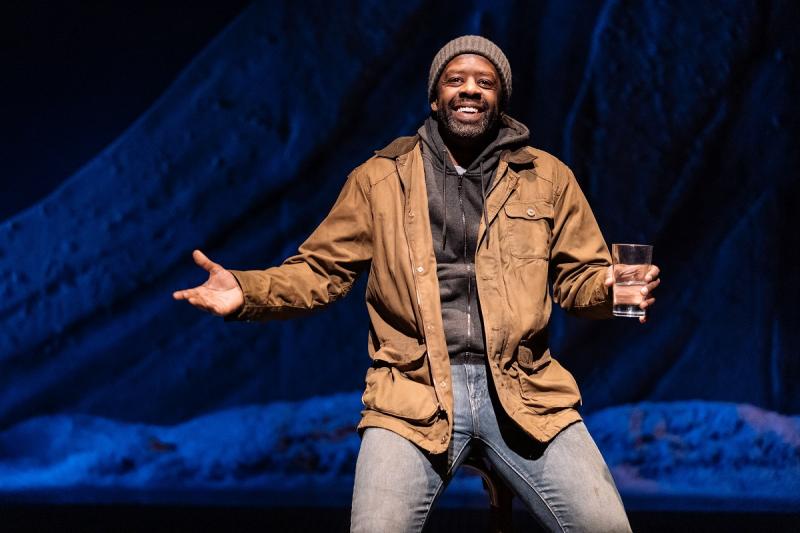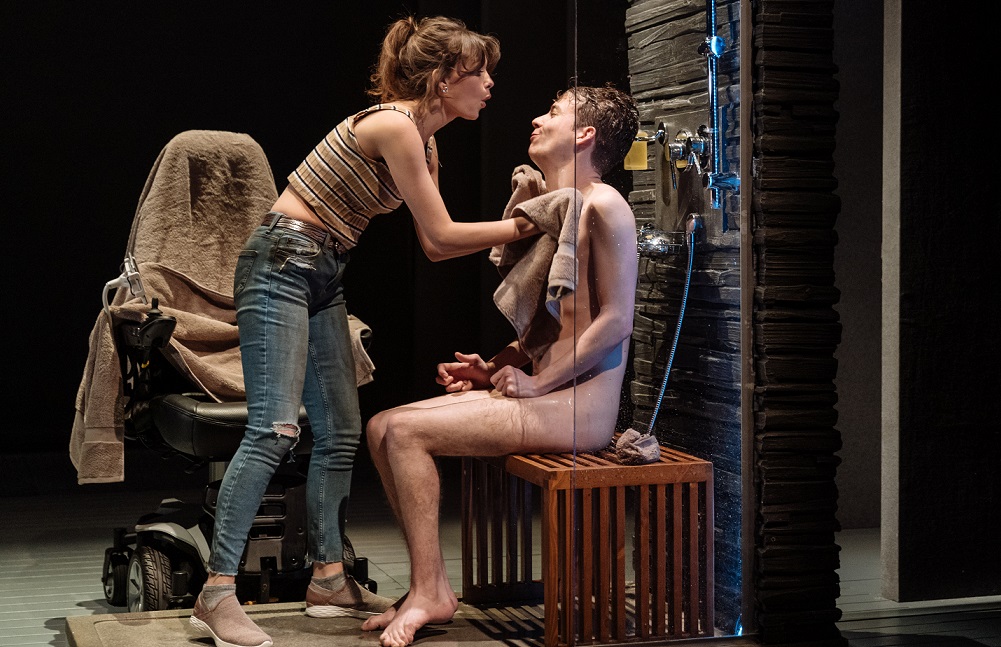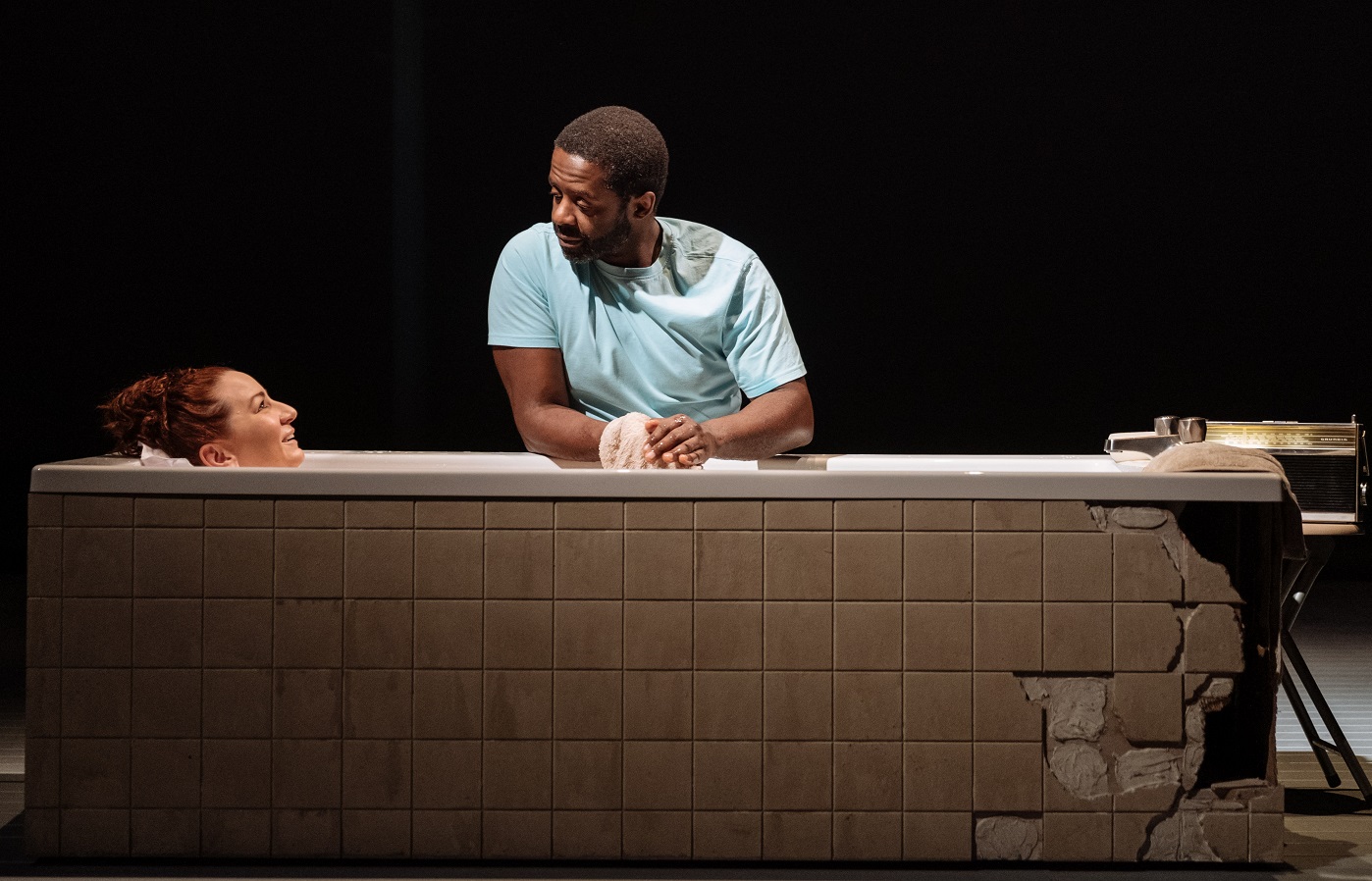Cost of Living, Hampstead Theatre review - tough but tender | reviews, news & interviews
Cost of Living, Hampstead Theatre review - tough but tender
Cost of Living, Hampstead Theatre review - tough but tender
Adrian Lester compels in new American drama about care and connection

The Off Broadway production of Cost of Living two years ago brought Martyna Majok the 2018 Pulitzer Prize for Drama, the height of acclaim of which most new writers – Majok, with four pla
As the title suggests, it shines a light on sections of American society that are increasingly challenged by economic circumstances, here the post-industrial subsistence suburbs of New Jersey where the Polish-American dramatist herself grew up. But there’s surely a more existential aspect to the phrase, too: life as an emotional abacus, if you like, keeping a tab on the pros and cons of existence. It’s a world where battles have to be fought, whether against disability, a central theme here, or to achieve human connection. While Majok’s emotional range extends wide, the landscape that her play charts is predominantly a bleak one.
Rigidity of dramatic structure and development of character don’t always meld
You wouldn’t immediately think so, however, from the comedic control with which Adrian Lester delivers its long opening monologue (pictured above). He plays Eddie, who’s expounding the story of his life and love across the fourth wall to a captive bar audience: his drinking days may be over, but he’s voluble, even poetic about the beauty and sadness of long-distance truck-driving (“roads are dark, and America is long”) – the sadnesses tend to dominate, especially when “the thoughts” take him over. Which they definitely have tonight, summoned mysteriously as he has been to this strange place by a call from his dead wife’s old number.
Majok’s timeline is elastic, and the structure of Cost of Living reveals itself gradually, its quartet of characters aligned into two separate story strands, both involving issues of physical care and of caring in a much wider sense. Eddie’s world revolves around his estranged wife Ani, into whose life he has come back after a car accident has left her with both legs amputated above the knee. Katy Sullivan premiered the role in the New York production and is utterly confident in Ani’s in-yer-face effusions, her drawling dismissive shtick and foul-mouthed verbal convolutions (she practically boasts of throwing “every awful string a’ words” at him). You’d think she’d be the last person anyone would want to be looking after but that’s what Eddie, driven by his own inner empty spaces, is suggesting. They have a history, at least. Which you can’t say about Majok’s second storyline, which has John, an affluent Princeton post-grad with cerebral palsy (played by Jack Hunter, who is, like Sullivan, disabled) being looked after by Jess (Emily Barber). His moneyed callowness contrasts with the young woman’s awkward uncertainties: a graduate too, she’s fallen on hard times, working flat out in different jobs. She may be managing to put a controlled front on all that, but there's a lot hiding behind it, not least her immigrant background: Majok doesn’t labour that aspect, though she's surely drawing partly on her own experiences, just as she doesn’t overdo the fact that Eddie is black. (Pictured above: Emily Barber, Jack Hunter)
Which you can’t say about Majok’s second storyline, which has John, an affluent Princeton post-grad with cerebral palsy (played by Jack Hunter, who is, like Sullivan, disabled) being looked after by Jess (Emily Barber). His moneyed callowness contrasts with the young woman’s awkward uncertainties: a graduate too, she’s fallen on hard times, working flat out in different jobs. She may be managing to put a controlled front on all that, but there's a lot hiding behind it, not least her immigrant background: Majok doesn’t labour that aspect, though she's surely drawing partly on her own experiences, just as she doesn’t overdo the fact that Eddie is black. (Pictured above: Emily Barber, Jack Hunter)
The dynamic of these two worlds brings an ambiguity to our balance of sympathies. Is it easier for Eddie to look after someone he knows so well, or for Jess who fulfils what is effectively a contact between strangers? Hardly, especially given Ani’s temperament, though the nasty hint of manipulation in John’s character qualifies any certaintiy. These interactions – helping to give a bath or shower – involve the pitiless exposure of nakedness and silent physical contact that speaks louder than words, elements that somehow involve an almost primal theatrical experience. The intimacy of touch is numinously inverted in one scene where Eddie washes Ani: her intimate parts are numb, so she feels nothing there, but when his fingers play out a silent piano melody on her arm, the effect is overwhelming, both tender and erotic. (Pictured below: Katy Sullivan, Adrian Lester) But rigidity of dramatic structure and development of character don’t always meld quite organically. It’s a shortcoming evident in the culminating scene between John and Jess, where an undeniable dramatic frisson is achieved at the expense of contrivance (though emotional misunderstanding is surely a perpetual hazard in this kind of “only connect” world). More significantly, it makes for a final scene that falls short, diluting too the writing’s hard acuity. Majok confronts the inherent dilemma of creating drama, a form predicated on interaction, about characters whose ability to make contact is itself restricted, where “degrees of separation” sunder rather than connect; where the heart is just too lonely a hunter to reach out across the divide. The oh-so-tentative final moment of Cost of Living does not fully repay expectations.
But rigidity of dramatic structure and development of character don’t always meld quite organically. It’s a shortcoming evident in the culminating scene between John and Jess, where an undeniable dramatic frisson is achieved at the expense of contrivance (though emotional misunderstanding is surely a perpetual hazard in this kind of “only connect” world). More significantly, it makes for a final scene that falls short, diluting too the writing’s hard acuity. Majok confronts the inherent dilemma of creating drama, a form predicated on interaction, about characters whose ability to make contact is itself restricted, where “degrees of separation” sunder rather than connect; where the heart is just too lonely a hunter to reach out across the divide. The oh-so-tentative final moment of Cost of Living does not fully repay expectations.
If that qualifies Majok’s overall achievement, the cumulative dramatic effect is considerable. It may sometimes seem a rather brittle text, but it's one that definitely expands into something more in Lester’s hands: he achieves a remarkable naturalness that is there too, albeit sometimes over-stridently, in Sullivan’s performance. Michael Pavelka’s wintry urban design captures the play’s frozen quality very well, a symphony of greys that is beautiful but cold, though its softly falling snow feels perhaps too poetic for this world. There’s a lonely lamppost that could have come from an Edward Hopper painting, which is where these fractured lives belong, too, illuminated as they are by rare, uncertain epiphanies that barely break the darkness that Majok makes elusively visible.
rating
Share this article
Add comment
The future of Arts Journalism
You can stop theartsdesk.com closing!
We urgently need financing to survive. Our fundraising drive has thus far raised £49,000 but we need to reach £100,000 or we will be forced to close. Please contribute here: https://gofund.me/c3f6033d
And if you can forward this information to anyone who might assist, we’d be grateful.

Subscribe to theartsdesk.com
Thank you for continuing to read our work on theartsdesk.com. For unlimited access to every article in its entirety, including our archive of more than 15,000 pieces, we're asking for £5 per month or £40 per year. We feel it's a very good deal, and hope you do too.
To take a subscription now simply click here.
And if you're looking for that extra gift for a friend or family member, why not treat them to a theartsdesk.com gift subscription?
more Theatre
 Ghost Stories, Peacock Theatre review - spirited staging but short on scares
Impressive spectacle saves an ageing show in an unsuitable venue
Ghost Stories, Peacock Theatre review - spirited staging but short on scares
Impressive spectacle saves an ageing show in an unsuitable venue
 Hamlet, National Theatre review - turning tragedy to comedy is no joke
Hiran Abeyeskera’s childlike prince falls flat in a mixed production
Hamlet, National Theatre review - turning tragedy to comedy is no joke
Hiran Abeyeskera’s childlike prince falls flat in a mixed production
 Rohtko, Barbican review - postmodern meditation on fake and authentic art is less than the sum of its parts
Łukasz Twarkowski's production dazzles without illuminating
Rohtko, Barbican review - postmodern meditation on fake and authentic art is less than the sum of its parts
Łukasz Twarkowski's production dazzles without illuminating
 Lee, Park Theatre review - Lee Krasner looks back on her life as an artist
Informative and interesting, the play's format limits its potential
Lee, Park Theatre review - Lee Krasner looks back on her life as an artist
Informative and interesting, the play's format limits its potential
 Measure for Measure, RSC, Stratford review - 'problem play' has no problem with relevance
Shakespeare, in this adaptation, is at his most perceptive
Measure for Measure, RSC, Stratford review - 'problem play' has no problem with relevance
Shakespeare, in this adaptation, is at his most perceptive
 The Importance of Being Earnest, Noël Coward Theatre review - dazzling and delightful queer fest
West End transfer of National Theatre hit stars Stephen Fry and Olly Alexander
The Importance of Being Earnest, Noël Coward Theatre review - dazzling and delightful queer fest
West End transfer of National Theatre hit stars Stephen Fry and Olly Alexander
 Get Down Tonight, Charing Cross Theatre review - glitz and hits from the 70s
If you love the songs of KC and the Sunshine Band, Please Do Go!
Get Down Tonight, Charing Cross Theatre review - glitz and hits from the 70s
If you love the songs of KC and the Sunshine Band, Please Do Go!
 Punch, Apollo Theatre review - powerful play about the strength of redemption
James Graham's play transfixes the audience at every stage
Punch, Apollo Theatre review - powerful play about the strength of redemption
James Graham's play transfixes the audience at every stage
 The Billionaire Inside Your Head, Hampstead Theatre review - a map of a man with OCD
Will Lord's promising debut burdens a fine cast with too much dialogue
The Billionaire Inside Your Head, Hampstead Theatre review - a map of a man with OCD
Will Lord's promising debut burdens a fine cast with too much dialogue
 50 First Dates: The Musical, The Other Palace review - romcom turned musical
Date movie about repeating dates inspires date musical
50 First Dates: The Musical, The Other Palace review - romcom turned musical
Date movie about repeating dates inspires date musical

Comments
I am blown away by the